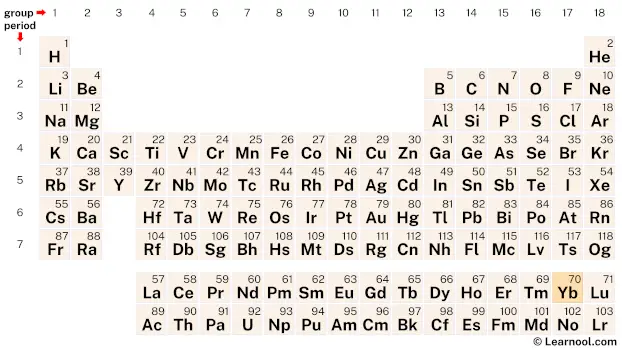
Ytterbium (Yb) is a chemical element of the periodic table, located in the period 6, and has the atomic number 70. It is the fourteenth element in the lanthanide series. It is a bright, soft, malleable, silvery-white metal, which is named after Ytterby, a village in Sweden, where it was mined. It is counted as one of the rare earth elements.
On periodic table
| group | ⇨ | 1 | 2 | 3 | 4 | 5 | 6 | 7 | 8 | 9 | 10 | 11 | 12 | 13 | 14 | 15 | 16 | 17 | 18 |
| period | ⇩ | ||||||||||||||||||
| 1 | 1 H  Hydrogen |
2 He  Helium |
|||||||||||||||||
| 2 | 3 Li  Lithium |
4 Be  Beryllium |
5 B  Boron |
6 C  Carbon |
7 N  Nitrogen |
8 O  Oxygen |
9 F  Fluorine |
10 Ne  Neon |
|||||||||||
| 3 | 11 Na  Sodium |
12 Mg  Magnesium |
13 Al  Aluminium |
14 Si Silicon |
15 P  Phosphorus |
16 S  Sulfur |
17 Cl  Chlorine |
18 Ar  Argon |
|||||||||||
| 4 | 19 K  Potassium |
20 Ca  Calcium |
21 Sc  Scandium |
22 Ti  Titanium |
23 V  Vanadium |
24 Cr  Chromium |
25 Mn  Manganese |
26 Fe  Iron |
27 Co  Cobalt |
28 Ni  Nickel |
29 Cu  Copper |
30 Zn  Zinc |
31 Ga  Gallium |
32 Ge  Germanium |
33 As  Arsenic |
34 Se  Selenium |
35 Br  Bromine |
36 Kr  Krypton |
|
| 5 | 37 Rb  Rubidium |
38 Sr  Strontium |
39 Y  Yttrium |
40 Zr  Zirconium |
41 Nb  Niobium |
42 Mo  Molybdenum |
43 Tc  Technetium |
44 Ru  Ruthenium |
45 Rh  Rhodium |
46 Pd  Palladium |
47 Ag  Silver |
48 Cd  Cadmium |
49 In  Indium |
50 Sn  Tin |
51 Sb  Antimony |
52 Te  Tellurium |
53 I  Iodine |
54 Xe  Xenon |
|
| 6 | 55 Cs  Caesium |
56 Ba  Barium |
72 Hf  Hafnium |
73 Ta  Tantalum |
74 W  Tungsten |
75 Re  Rhenium |
76 Os  Osmium |
77 Ir  Iridium |
78 Pt  Platinum |
79 Au  Gold |
80 Hg  Mercury |
81 Tl  Thallium |
82 Pb  Lead |
83 Bi  Bismuth |
84 Po  Polonium |
85 At  Astatine |
86 Rn  Radon |
||
| 7 | 87 Fr  Francium |
88 Ra  Radium |
104 Rf  Rutherfordium |
105 Db  Dubnium |
106 Sg  Seaborgium |
107 Bh  Bohrium |
108 Hs  Hassium |
109 Mt  Meitnerium |
110 Ds  Darmstadtium |
111 Rg  Roentgenium |
112 Cn  Copernicium |
113 Nh  Nihonium |
114 Fl  Flerovium |
115 Mc  Moscovium |
116 Lv  Livermorium |
117 Ts  Tennessine |
118 Og  Oganesson |
||
| 57 La  Lanthanum |
58 Ce  Cerium |
59 Pr  Praseodymium |
60 Nd  Neodymium |
61 Pm  Promethium |
62 Sm  Samarium |
63 Eu  Europium |
64 Gd  Gadolinium |
65 Tb  Terbium |
66 Dy  Dysprosium |
67 Ho  Holmium |
68 Er  Erbium |
69 Tm  Thulium |
70 Yb Ytterbium |
71 Lu  Lutetium |
|||||
| 89 Ac  Actinium |
90 Th  Thorium |
91 Pa  Protactinium |
92 U  Uranium |
93 Np  Neptunium |
94 Pu  Plutonium |
95 Am  Americium |
96 Cm  Curium |
97 Bk  Berkelium |
98 Cf  Californium |
99 Es  Einsteinium |
100 Fm  Fermium |
101 Md  Mendelevium |
102 No  Nobelium |
103 Lr  Lawrencium |
|||||
| – f block |
Ytterbium is a member of the lanthanide series, a group of elements located at the bottom of the periodic table. It can be found in period 6, between thulium (Tm) and lutetium (Lu).
Element information
 |
|
 |
|
| Origin of name | named after Ytterby, a village in Sweden |
| Symbol | Yb |
| Atomic number (Z) | 70 |
| Atomic mass | 173.04 u |
| Block | f-block |
| Period | 6 |
| Classification | Lanthanide |
| Atomic radius | 176 pm |
| Covalent radius | 187±8 pm |
| Melting point | 824 ℃, 1515 ℉, 1097 K |
| Boiling point | 1196 ℃, 2185 ℉, 1469 K |
| Electron configuration | [Xe] 4f14 6s2 |
| Electrons per shell | 2, 8, 18, 32, 8, 2 |
| Crystal structure | Face-centered cubic (fcc) |
| Phase at r.t | Solid |
| Density near r.t | 6.90 g/cm3 |
| Main isotopes | Ytterbium-168, Ytterbium-170, Ytterbium-171, Ytterbium-172, Ytterbium-173, Ytterbium-174 |
| Natural occurrence | Primordial |
| Oxidation state | +3 |
| Electronegativity (Pauling scale) | 1.1 |
| Protons Neutrons Electrons |
70 103 70 |
| Learn how to find: Ytterbium protons neutrons electrons | |
| CAS number | 7440-64-4 |
| Discovered by | Jean Charles Galissard de Marignac in 1878 |
History

Ytterbium was discovered by Swiss chemist Jean Charles Galissard de Marignac in 1878 while he was studying the composition of the mineral gadolinite. He found a new component in the mineral that he named ytterbia after Ytterby, a town in Sweden where other rare earth elements were discovered. In 1907, French chemist Georges Urbain isolated a pure form of ytterbium from a sample of erbium that he had extracted from gadolinite. The element was named after the town of Ytterby, which had also given its name to four other rare earth elements.
During the 20th century, ytterbium was primarily produced as a byproduct of other rare earth element mining and refining processes. However, in recent years, new sources of ytterbium have been discovered and extraction methods have been developed that allow for more efficient production. Today, the majority of ytterbium is obtained from the minerals monazite and xenotime, as well as from spent nuclear fuel.
Occurrence and production
Ytterbium is a rare earth element that occurs in nature in small quantities, usually together with other rare earth elements. It is mainly found in the minerals gadolinite, euxenite, and xenotime.
The most common method of producing ytterbium is through ion exchange or solvent extraction processes that separate ytterbium from other rare earth elements. Ytterbium can also be produced through the reduction of ytterbium trifluoride with calcium metal. The process involves the reaction of calcium metal with ytterbium trifluoride, which produces ytterbium and calcium fluoride.
Properties
Ytterbium is a silvery-white metal that is relatively soft and ductile.
It has a hexagonal close-packed crystal structure and is paramagnetic at room temperature.
Ytterbium has a high melting point of 824 ℃ and a boiling point of 1196 ℃.
It is a good conductor of electricity and has a relatively low thermal conductivity.
Ytterbium is highly reactive with oxygen, and forms a protective oxide layer when exposed to air.
It is soluble in both acids and alkalis, and reacts with water to form ytterbium hydroxide and hydrogen gas.
Ytterbium has several isotopes, with Yb-174 being the most abundant, and Yb-169 and Yb-170 being used in nuclear medicine.
Ytterbium has unique optical properties, with its ions being used in lasers and amplifiers due to their ability to emit light at specific wavelengths.
Applications
Atomic clocks
Ytterbium has a unique electron structure that makes it an excellent atomic clock material. Atomic clocks based on ytterbium are currently the most accurate timekeepers in the world, with accuracy levels of one second in 15 billion years.
Medical imaging
Ytterbium-169 is a radioactive isotope that is used in brachytherapy, a type of cancer treatment where radioactive sources are placed inside or next to the cancerous tissue to deliver high doses of radiation. Ytterbium-169 has a relatively short half-life of 32 days, which means it decays quickly and does not stay in the body for an extended period.
Nuclear reactors
Ytterbium can be used as a neutron absorber in nuclear reactors to control the rate of fission reactions. Its high neutron capture cross-section makes it useful for regulating the nuclear chain reaction and preventing overheating.
Fiber-optic amplifiers
Ytterbium-doped fiber-optic amplifiers are used in telecommunications and data storage applications to boost the strength of signals traveling through fiber-optic cables. Ytterbium’s unique electron structure makes it well-suited for this purpose.
Metal alloys
Ytterbium can be added to metal alloys to improve their mechanical properties, such as strength, hardness, and ductility. It is commonly added to stainless steel, aluminum, and titanium alloys.
Interesting facts
Ytterbium is the most volatile rare earth element, meaning it can easily evaporate into the air at room temperature.
It has the highest electrical conductivity of all rare earth metals.
The element was named after the Swedish village of Ytterby, where several rare earth minerals were discovered.
Ytterbium has potential applications in atomic clocks and lasers, as well as in medicine for cancer treatment.
It is also used in the production of stainless steel and in the nuclear energy industry.
Ytterbium can absorb a large amount of energy and emit it as light, making it useful for developing high-efficiency solar cells.
Ytterbium can also be used as a dopant in fiber optic amplifiers for telecommunication applications.
Related
More elements
External links
- https://en.wikipedia.org/wiki/Ytterbium
- https://www.rsc.org/periodic-table/element/70/ytterbium
- https://www.britannica.com/science/ytterbium
- https://www.chemicool.com/elements/ytterbium.html
- https://pubchem.ncbi.nlm.nih.gov/element/Ytterbium
Deep
Learnool.com was founded by Deep Rana, who is a mechanical engineer by profession and a blogger by passion. He has a good conceptual knowledge on different educational topics and he provides the same on this website. He loves to learn something new everyday and believes that the best utilization of free time is developing a new skill.
